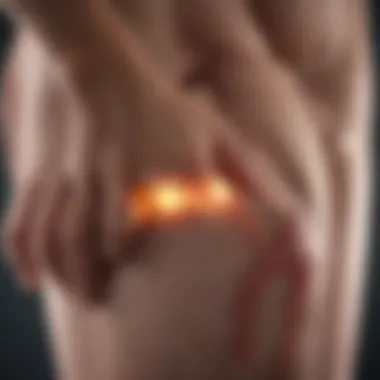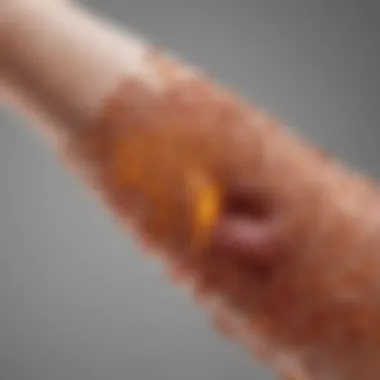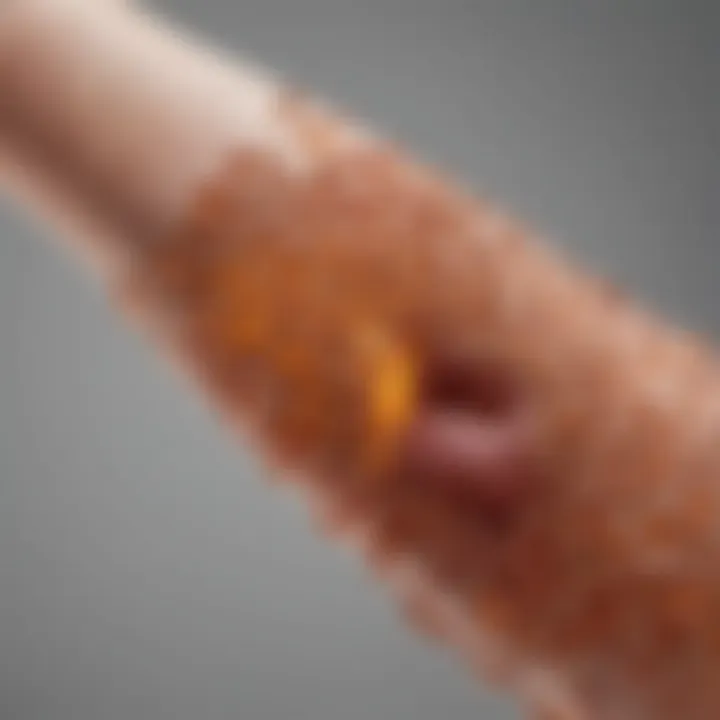Exploring the Link Between Hives and Joint Pain


Intro
The intersection of hives and joint pain might not seem obvious at first glance. Yet, for many individuals navigating chronic conditions, these two symptoms can emerge in tandem, raising questions about their connections. Hives, medically known as urticaria, manifest as raised welts on the skin, often accompanied by itching. On the other hand, joint pain can range from mild discomfort to severe, hindering mobility and overall quality of life. Understanding the threads binding these seemingly disparate ailments requires delving into their potential causes and pathophysiological links.
As the body responds to various internal and external stimuli, it engages in complex processes that can trigger both dermatological and rheumatological symptoms. The interplay between immune responses, environmental factors, and underlying health conditions warrants a thorough examination. By doing so, we can better address the challenges posed by both hives and joint pain, leading to more effective management strategies.
Recent studies have suggested that certain triggers—such as allergens, medications, or infections—can simultaneously provoke hives and exacerbate joint pain. This overlap might also point toward autoimmune disorders or systemic diseases that require a multifaceted approach to treatment. Through this exploration, the aim is to provide clarity for researchers, clinicians, and patients alike, emphasizing the importance of recognizing these connections in clinical practice.
In the sections that follow, we will present findings that not only outline the relationship between hives and joint pain but also highlight the implications of these insights for research and treatment. By synthesizing existing literature, expert opinions, and case studies, this article seeks to foster a deeper understanding of how these conditions may be intertwined.
Intro to Hives and Joint Pain
The connection between hives and joint pain might not be clear at first glance, but understanding their relationship is essential for both patient care and further research. Hives, known scientifically as urticaria, are uncomfortable skin reactions often characterized by itchy welts. Joint pain, on the other hand, can emerge from various underlying conditions, affecting mobility and quality of life. These two seemingly unrelated symptoms may share common roots in terms of immune responses and inflammation.
Recognizing this interplay is crucial for healthcare professionals who are tasked with diagnosing and treating patients presenting with symptoms of either condition. A comprehensive understanding of hives and joint pain can lead to improved management strategies, relieving discomfort for those who suffer from them. A deeper dive into these conditions will offer clarity on why they may occur simultaneously and how they can impact a person's overall health.
By exploring the specific elements that connect hives to joint pain, one can gain insight into potential triggers, progression of symptoms, and important treatment avenues. This examination can serve as a guide for formulating practical advice that encompasses both dermatological and rheumatological aspects. The implications stem from how these interactions might inform prevention strategies, diagnostic approaches, and an individualized approach to patient care.
The following sections will delve into defining hives, understanding joint pain, and examining their intersection, ultimately aiming to synthesize this information for heightened awareness and knowledge across academic and clinical fields.
Defining Hives
Hives are a type of skin rash characterized by raised, itchy welts. These can appear anywhere on the body and often change in shape, size, and location. Hives can be acute, lasting less than six weeks, or chronic, persisting for six weeks or longer. The welts result from the release of histamine and other chemicals within the skin, typically an immune response to an allergen or irritant.
While hives can be triggered by countless factors, ranging from food allergies to medication, certain underlying conditions can contribute to their development. Importantly, the visibility of hives often leads patients to seek immediate relief, turning attention away from their potential association with other health issues, such as joint pain.
Understanding Joint Pain
Joint pain affects many individuals, manifesting in various degrees of severity. It can result from disease processes like arthritis or injury and can be acute or chronic in nature. When discussing joint pain, it is crucial to differentiate between types, such as osteoarthritis, a degenerative joint disease, and rheumatoid arthritis, an autoimmune disorder. Both can have profound implications on a person's functional ability and overall well-being.
The mechanisms behind joint pain often involve inflammation, swelling, and damage to the joint structures. It is vital for individuals experiencing joint pain to realize that treating the symptom is not always sufficient; understanding the underlying cause can lead to more effective management and prevention.
The Intersection of Hives and Joint Pain
The intersection of hives and joint pain opens a fascinating dialogue. Hives can signify broader systemic issues, including autoimmune responses, which might also be responsible for joint pain. For instance, conditions like lupus and Sjögren's syndrome, both autoimmune in nature, have well-documented links to joint pain and can also present with skin symptoms such as hives.
While the physical symptoms are different, the underlying immune mechanisms can display a tight-knit relationship that leads to both skin and joint complaints. Recognizing these connections not only aids in diagnosis but can also pave the way for a broader understanding of treatment strategies that address both issues simultaneously.
"Understanding the connections between symptoms is fundamental for effective patient treatment and management."
In summary, the relationship between hives and joint pain is more than merely coincidental. As we continue to explore the implications of this intersection, it becomes imperative to adopt a holistic perspective in assessing and treating these conditions.
Pathophysiology of Hives and Joint Pain
The pathophysiology of hives and joint pain is a crucial area of inquiry for understanding how these two seemingly distinct issues may interrelate. When we look closely at this interplay, we uncover several layers of immune response, inflammatory processes, and potentially autoimmune phenomena that provide insight into both conditions. Understanding these connections can ultimately guide more effective management strategies for both patients and healthcare professionals.
Immune System Involvement
The immune system serves as the body's first line of defense against various pathogens. However, its mismanagement or overreaction to stimuli can lead to conditions like hives (urticaria) and joint pain. In hives, the immune system responds to certain triggers—such as allergens, medications, or environmental factors—by releasing histamines. This reaction can lead to localized swelling, redness, and itchiness on the skin.
In parallel, joint pain often involves the immune system, particularly in cases of autoimmune disorders. For instance, rheumatoid arthritis involves the immune system attacking joint tissues, resulting in inflammation and damage. The overlapping immune mechanisms in these conditions can provide a valuable perspective on why someone experiencing hives may also report joint pain.
The interconnection of these responses calls for thorough research into how these immune factors might interact, highlighting the importance of individualized treatment plans.
Histamine Release and Inflammation
Histamine release is a key player in both hives and joint pain. When triggered, mast cells in the skin direct the release of histamines, leading to the well-recognized symptoms associated with hives. Histamine is a powerful compound that increases the permeability of blood vessels, allowing fluids to escape into the surrounding tissue. This can result in swelling and redness, hallmark characteristics of hives.
On the joint side of things, histamine's role isn't quite as clear cut. It's been shown to influence inflammation in joint tissues as well. When histamine levels rise due to an allergic reaction or another trigger, it can amplify the inflammatory response at the joints, leading to increased pain and swelling. This dual role of histamine in hives and joint pain underscores the necessity for a holistic approach to treatment, because addressing histamine levels could potentially benefit individuals suffering from both conditions.
Autoimmune Factors
Autoimmune diseases present a complex layer when examining the pathophysiology of hives and joint pain. Conditions like lupus or scleroderma can present with both skin manifestations and joint symptoms. In these cases, the immune system is mistakenly recognizing the body's own tissues as foreign and mounting a response against them. Hives can sometimes appear in response to these autoimmune processes, effectively making the skin a battleground of sorts for the immune system.


Recognizing that autoimmune mechanisms could be at play allows clinicians to consider a broader differential diagnosis. It’s not just about treating the immediate symptoms—understanding these underlying autoimmune factors can lead to more targeted therapies that address the root cause of inflammation and pain. For individuals experiencing both hives and joint pain, a careful evaluation of autoimmune indicators could open doors to more effective management strategies.
"The relationship between hives and joint pain isn't just skin deep; it warrants a deep dive into the immune pathways that unite them."
In closing, dissecting the pathophysiology of hives and joint pain reveals a tapestry woven from immune responses, histamine activities, and autoimmune influences. This understanding not only enriches our knowledge base but significantly enhances our approach to managing these interconnected conditions.
Common Causes of Hives
Hives, medically termed urticaria, occur when the body experiences an allergic reaction, inflammation, or irritation leading to raised, itchy welts or bumps. Recognizing the common causes of hives is crucial, as it not only aids in swift diagnosis but also in effective management. Causes can vary significantly from person to person. Some may find their hives triggered by specific foods, while others might react to environmental factors. Understanding these causes serves as a pathway to prevention and control, especially for individuals who suffer recurrent episodes.
Allergic Reactions
Allergic reactions are the most well-known triggers for hives. When the immune system mistakenly identifies a harmless substance as a threat, it releases histamines and other chemicals. These can result in that tell-tale itchy rash. The scope of allergens is broad and includes:
- Foods, like peanuts, shellfish, milk, and eggs
- Medications, including antibiotics and non-steroidal anti-inflammatory drugs (NSAIDs)
- Insect stings or bites shining a spotlight on the complex interactions within our body
For many, keeping a food diary or noting when reactions occur can help pinpoint the culprit. This proactive approach often leads to better management, as knowing the enemy allows for avoidance.
Infections and Inflammatory Conditions
Certain infections and underlying inflammatory conditions can also trigger hives. Viral infections, in particular, can elicit hives as the body responds to fight them off. Beyond just viruses, conditions like lupus or thyroid disorders sometimes present as hives due to the body's heightened immune response.
In this instance, hives may not occur in isolation. They can accompany other symptoms such as:
- Fever associated with viral or bacterial infections
- Joint pain indicating inflammatory processes
- Swelling, showing the body's reaction to infection
Being vigilant about other symptoms accompanying hives can help in diagnosing the root cause more effectively.
Environmental Triggers
Environmental factors exert a significant influence over the occurrence of hives. Temperature changes, pressure on the skin, sunlight, or even sweating can provoke them. These conditions vary dramatically, making them sometimes hard to track. Identifying patterns among these environmental triggers can prove beneficial for individuals prone to hives. Consider some of these examples:
- Physical triggers: Wearing tight clothing or being in contact with certain fabrics like wool
- Weather-related triggers: Sudden cold weather or intense heat exposure
- Chemical triggers: Household cleaners or heavy perfumes
"Many people might be surprised at how their environment influences their skin's reactions. It's not just what we consume but how we live that affects our health."
Understanding the varied causes of hives is a cornerstone for effective management. Whether reactions stem from an allergic source, an infection, or environmental issues, identifying the trigger is essential in maintaining a higher quality of life. Naturally, this discussion flows into the next part of our exploration - the causes of joint pain, where we will uncover whether there's a possible connection between these two distinct issues.
Common Causes of Joint Pain
Joint pain, a widespread ailment, can severely impact one's quality of life. Understanding the common causes of joint pain is crucial in identifying possible correlations with other conditions, such as hives. It helps in crafting a comprehensive evaluation of the patient's health. Additionally, by exploring the causes, healthcare professionals can tailor treatment strategies that are effective and individualized. This section aims to shed light on various conditions contributing to joint pain while linking it back to the broader implications of hives and how they can intertwine.
Osteoarthritis
Osteoarthritis, often termed wear-and-tear arthritis, is a degenerative disorder prominently affecting older adults. Over time, the cartilage cushioning the joint surfaces deteriorates, resulting in pain, stiffness, and swelling. The knees, hips, and hands are common sites of discomfort.
There are several factors that may heighten the risk of developing osteoarthritis. These include:
- Age: Incidence increases with advancing age.
- Weight: Excess body weight adds stress to weight-bearing joints.
- Previous Injuries: Any joint injury can predispose one to this condition.
- Genetics: Family history can play a significant role in susceptibility.
Research suggests that chronic inflammation seen in hives could aggravate joint pain, making it essential for clinicians to consider both joint health and skin conditions during diagnosis.
Rheumatoid Arthritis
Rheumatoid arthritis (RA) is an autoimmune condition where the immune system mistakenly attacks the joints, causing inflammation. Unlike osteoarthritis, RA can affect joints symmetrically, meaning both sides of the body are often involved at the same time. Symptoms can range from mild to severe, with periods of exacerbation and remission.
Key characteristics of rheumatoid arthritis include:
- Morning Stiffness: Many individuals experience stiffness that eases throughout the day.
- Fatigue and Fever: Patients may frequently feel tired or run a low fever.
- Joint Swelling: Redness may accompany swelling in affected joints.
It’s significant to note that as autoimmune responses impact various body systems, the implications of hives, which can also be an autoimmune response, can lead to similar experiences of joint discomfort in some patients.
Gout and Other Specific Conditions


Gout is a type of inflammatory arthritis characterized by sudden, severe attacks of pain, swelling, and redness in joints, often starting in the big toe. It results from the accumulation of urate crystals, which can develop if there’s an excess of uric acid in the blood.
The triggers for gout include:
- Diet: High-purine foods like red meat and shellfish.
- Dehydration: Low fluid intake increases uric acid concentration.
- Medications: Some diuretics can elevate uric acid levels.
Other specific conditions to consider might be psoriatic arthritis or ankylosing spondylitis, both of which have links to skin conditions similar to hives. This connection indicates a need for a holistic approach to treatment, with dermatological and rheumatological collaboration playing a pivotal role in patient management.
Case Studies: Notable Connections
In the exploration of hives and joint pain, case studies play a vital role in bridging theoretical understanding with real-world experiences. They allow us to see how abstract concepts manifest in individual patients, often revealing nuanced connections that might otherwise remain obscured in broader clinical observations. The detailed examination of these case studies not only enhances our grasp of the potential interplay between these two conditions but also highlights distinctive patterns that could guide future research and clinical approaches.
One of the critical elements of studying case studies is their unique ability to illuminate atypical symptoms or responses to treatment. For instance, certain patients may present with a dual diagnosis—simultaneous hives and joint pain—following an allergic reaction that triggers both histamine release and inflammation in joints. Recognizing these patterns could be beneficial in developing more tailored treatment regimens.
Moreover, the benefits of integrating case studies into clinical practice are manifold. They foster a greater understanding of patient experiences, which can lead to more empathetic care. The insights gained from a case study often raise questions that can spur further investigation, thereby enriching the overall field of study. This ongoing inquiry is essential, as it promotes a dynamic and evolving approach to patient care.
Case Study Insights into Hives and Joint Symptoms
Examining specific instances where patients have experienced hives co-occurring with joint pain reveals a rich tapestry of triggers and responses. For instance, one notable case involved a 35-year-old woman who developed hives after consuming shellfish. Simultaneously, she reported swelling in her knee joints. Initial treatments focused on antihistamines, but the persistence of her joint symptoms warranted further evaluation.
Upon closer examination, it was discovered that she had a history of autoimmune conditions. This context shifted the treatment approach from solely managing her allergic reaction to addressing the underlying inflammation affecting her joints. In this case, it was paramount to consider not just the hives but also the systemic implications they had on her joint health.
Insights like this allow health professionals to recognize that joint pain can serve as a significant indicator of broader systemic issues, particularly when presented alongside dermatological symptoms.
Analysis of Clinical Patterns
The assessment of clinical patterns across multiple case studies can unearth noteworthy trends and correlations between hives and joint pain. For instance, a review of 50 patients exhibiting both conditions revealed several recurring triggers, including viral infections and certain medications. These findings lend credence to the hypothesis that both symptoms may arise from a shared pathophysiological pathway—one that is influenced by immune system activities and external exposures.
Additionally, the variability in patient responses to treatments suggests that a one-size-fits-all approach may not be sufficient. Understanding how individual patients respond differently can inform tailored interventions that are more effective.
As we analyze these patterns, we’re not just gaining knowledge but are also paving the way for improved diagnostic frameworks. Furthermore, by identifying commonalities among the patients studied, healthcare providers can adopt more proactive strategies, refining interventions to mitigate symptoms effectively before they escalate.
Diagnosis of Hives and Joint Pain Correlation
Diagnosing the connections between hives and joint pain is a nuanced process that presses into the intricacies of both dermatological and rheumatological evaluations. As both symptoms can arise from the same underlying causes, recognizing their relationship can greatly facilitate effective treatment.
Diagnostic Criteria for Hives
When it comes to hives, or urticaria, the criteria for diagnosis can be broken down into several pivotal points:
- Appearance: Hives typically present as raised, itchy welts on the skin that can vary in shape and size. These can pop up and dissipate within hours, often leading to a puzzling experience for both patient and clinician.
- Duration and Recurrence: Hives can be acute, lasting less than six weeks, or chronic, extending for more than six weeks. Properly categorizing this duration is essential in guiding treatment and understanding potential triggers.
- Associated Symptoms: It's crucial to note if the hives are accompanied by other symptoms such as swelling, which can indicate anaphylaxis in severe allergic reactions. This might connect to joint pain through an underlying allergic response that could simultaneously exacerbate rheumatic issues.
- History and Triggers: A comprehensive patient history is vital. Patients should be questioned about recent exposure to allergens, stressors, or physical triggers, such as pressure or temperature changes.
Assessing Joint Pain: Tools and Techniques
When evaluating joint pain, several tools and techniques can aid in forming a clear picture:
- Physical Examination: Initial assessments often begin with a physical examination where the healthcare provider observes and palpates the affected joints for swelling, heat, or tenderness.
- Medical History Taking: Similar to hives, understanding the patient’s previous medical history and any family history of joint disorders can be revealing. Clarity on the type of pain (e.g., sharp, dull, constant, or intermittent) can significantly shape a diagnosis.
- Imaging Techniques: Radiology plays a key role. X-rays can reveal joint damage, while MRI scans can help identify soft tissue involvement, swelling, or inflammation that might link to symptoms like hives.
- Laboratory Tests: Blood tests can detect indicators of inflammation, autoimmune reactions, or infections that might be at play. For instance, checking for rheumatoid factor or anti-nuclear antibodies can assist in diagnosing conditions like rheumatoid arthritis, which could coexist with hives.
As healthcare continues to evolve, the importance lies in taking a holistic view of symptoms. Understanding the correlation between hives and joint pain can not only lead to personalized treatments but also help to uncover underlying health conditions that need addressing. The stakes are high, and timely diagnoses are crucial.
Management of Hives
Managing hives is a crucial element in the broader discussion of hives and joint pain correlations. Often, people see hives merely as an annoying skin issue; they might not realize that effective management strategies can greatly influence overall symptoms and improve quality of life. This section aims to explore some essential components of managing hives, focusing on medications, lifestyle changes, and their implications.
Antihistamines and Other Medications
Antihistamines play a pivotal role in alleviating the symptoms of hives. These medications function by blocking the effects of histamine, a substance released during allergic reactions that leads to itching and swelling. Over-the-counter options, like diphenhydramine and cetirizine, are often the first line of defense. However, it’s vital to consult a healthcare provider for suggestions tailored to individual needs.
Moreover, some cases may warrant prescription medications, such as corticosteroids, particularly if hives become chronic or severe. In such instances, doctors might also explore options like omalizumab, which is used for persistent chronic hives that do not respond to regular treatments. The choice of treatment depends largely on the severity of the condition and individual patient factors.
"Addressing hives effectively can also prevent secondary impacts on joint pain, by minimizing inflammation and discomfort."
It’s also important to realize that, while medications can provide quick relief, they do not always tackle the underlying cause. Therefore, self-observation plays a significant role in identifying triggers for further management.


Lifestyle Modifications
In conjunction with medication, lifestyle modifications can offer substantial improvements in managing hives. One key change often recommended involves dietary adjustments. For example, people might find specific foods exacerbate their symptoms. Common culprits include shellfish, nuts, or even food additives. Keeping a food diary can help pinpoint these triggers.
Additionally, stress reduction techniques, such as yoga or meditation, can help alleviate symptoms since stress is known to trigger hives in some individuals. Regular exercise is another beneficial lifestyle modification, as it improves circulation and may assist the immune system, further supporting overall health.
Furthermore, the importance of a cool environment cannot be overstated. Heat can aggravate hives, so using fans or cool baths can provide immediate relief for those experiencing flare-ups.
In summary, managing hives requires a multifaceted approach that combines medications with thoughtful lifestyle changes. Each person's journey will be unique, and understanding this can empower individuals to take control of their symptoms, keeping the connections to joint pain in mind.
Management of Joint Pain
Effective management of joint pain is crucial for anyone dealing with this condition. Joint pain can arise from various reasons, including previous injuries, chronic conditions, or just the wear and tear of everyday life. Understanding how to manage this pain not only improves one’s quality of life but also affects overall physical health, mental well-being, and even social interactions.
Addressing joint pain is not merely about alleviating discomfort; it often requires a multifaceted approach. This focuses on tackling both the immediate symptoms and the underlying causes. Not all joint pain is created equal, so strategies for management may differ from person to person. With this article, we aim to streamline various methods and highlight their individual benefits.
Pharmacological Approaches
When it comes to easing joint pain, pharmacological interventions play a significant role. Medications can be categorized into a few key types, and understanding these can help one make informed choices.
- Nonsteroidal Anti-inflammatory Drugs (NSAIDs): Drugs like ibuprofen or naproxen are commonly used. They relieve pain and reduce inflammation but should be used sparingly due to potential side effects, including gastrointestinal issues.
- Corticosteroids: In some cases, injections directly into the joint can help manage inflammation effectively. This route is often prescribed for specific conditions like gout or rheumatoid arthritis.
- Disease-Modifying Antirheumatic Drugs (DMARDs): These are primarily used for chronic autoimmune problems. They can dramatically change how the disease progresses, which helps in reducing joint pain over long periods. Minocycline could be one example, depending on underlying conditions.
- Topical Analgesics: Creams and gels applied directly to the skin can provide localized relief. They can be pretty effective with fewer systemic side effects compared to oral medications.
It's essential to consult with a healthcare professional before starting a medication regimen, as some options can interact poorly with other treatments or medical conditions.
Physical Therapy and Rehabilitation
Another vital aspect of managing joint pain involves physical therapy and rehabilitation. Often, patients may shy away from movement fearing it will exacerbate the pain. This is, however, a misconception because targeted physical therapy can offer substantial benefits.
Working with a trained physiotherapist, individuals can engage in tailored exercises to improve flexibility, strength, and mobility in the affected joints. Some approaches include:
- Strength Training: Building muscle around the joints provides stability and can reduce the likely pain.
- Stretching Exercises: These increase the range of motion and prevent stiffness, which is often a common complaint.
- Aquatic Therapy: Utilizing water supports joint movements while minimizing stress on them, making it easier to exercise.
- Manual Therapy: This hands-on treatment can relieve tension, improve circulation, and can enhance joint movement.
A study highlighted that individuals who participate in physical therapy tailored to their specific condition report a significant decrease in pain and an increase in overall quality of life.
"The aim of physical therapy is not just to get rid of pain, but to empower you to regain control over your mobility."
Preventative Measures
Preventative measures are more than just a safety net; they’re a proactive approach to managing the complexities of conditions like hives and joint pain. Recognizing the significance of prevention can’t be overstated. After all, avoiding the triggers that precipitate these issues is often more efficacious than handling the consequences. Taking the road less traveled here not only shields one from discomfort but also fosters overall well-being.
Lifestyle Changes to Reduce Risks
Changing daily habits can lead to profound benefits. These may include:
- Dietary modifications: Adopting an anti-inflammatory diet can play a crucial role. Incorporating foods rich in omega-3 fatty acids, like salmon or flaxseeds, alongside vibrant fruits and leafy greens, can be game-changing. Some people even find that cutting dairy or refined sugars helps to keep their immune systems calmer.
- Regular physical activity: Engaging in exercise that's appropriate for one's condition can greatly reduce joint pain while boosting the body's overall health. Activities like swimming or cycling are often recommended, as they are low-impact yet effective.
- Stress management: Stress can act as a catalyst for both hives and joint pain flare-ups. Techniques such as mindfulness, meditation, or even simple breathing exercises can be incredibly helpful.
- Adequate hydration: Water plays a silent yet significant role. Staying properly hydrated helps in maintaining skin elasticity and joint lubrication. Sometimes, we forget the basics can make the biggest difference.
While these lifestyle changes might seem uncomplicated, they hold the potential to reduce the overall risk and severity of symptoms. Engaging with healthcare professionals can provide tailored advice, ensuring that individual needs are met.
Monitoring and Early Intervention
Keeping a close eye on one’s health can pay dividends. Early intervention can often be the difference between a small bump in the road and a major detour. Key considerations include:
- Keeping a symptom diary: Jotting down triggers, symptoms, and responses to treatments can help construct a clearer picture of what exacerbates or alleviates issues. Over time, patterns may emerge that were previously unnoticed.
- Regular check-ups: Staying on top of medical check-ups is crucial, especially in the context of chronic illness. A healthcare provider's keen eye can catch potential problems before they escalate.
- Education: Familiarizing oneself with potential warning signs is invaluable. Knowing when to seek help can make a significant difference in outcomes. Learning about medications that can prevent flare-ups, such as antihistamines, is also beneficial.
- Engaging support networks: Connecting with others facing similar challenges can create a sense of community. Sometimes, simply discussing worries or tips with peers can spark valuable insights.
By valuing preventative measures, individuals may not just mitigate the impact of hives and joint pain; they can also cultivate a proactive mindset, nurturing a healthier life in general. Investing time in lifestyle adjustments and vigilant monitoring can lead to increased quality of life and reduced symptom severity.
Finale
The significance of understanding the connections between hives and joint pain cannot be overstated. As these conditions increasingly intersect in patients, recognizing their implications enhances our approach to treatment. Disentangling the complexities of hives and joint pain requires an appreciation of both dermatological and rheumatological perspectives. This broader understanding can lead to more effective management strategies, ultimately improving patient outcomes.
Summary of Key Findings
- Pathophysiology Links: The immune system plays a critical role in both hives and joint pain. The mechanisms underpinning histamine release and inflammation can illuminate overlapping pathways.
- Common Triggers: Both conditions share a variety of triggers, from allergic reactions to autoimmune responses. Identifying these can be key in both diagnosis and treatment.
- Case Studies Highlighting Connections: Clinical patterns observed in specific cases offer insights into how these symptoms can manifest together, guiding clinicians towards more comprehensive care.
- Management Strategies: Effective management encompasses pharmacological approaches, lifestyle modifications, and physical therapy targeting both hives and joint pain simultaneously, fostering holistic well-being.
Future Directions for Research
The exploration of the links between hives and joint pain is still in its infancy, suggesting multiple avenues for future research. Some areas worth investigating include:
- Genetic Studies: Understanding any hereditary connections could improve risk assessment and early intervention strategies.
- Longitudinal Studies: Tracking patients over time could reveal further insights into how these conditions influence each other, potentially leading to new therapeutic targets.
- Innovative Treatments: Research into tailored therapies that simultaneously address both skin and joint symptoms might significantly enhance quality of life for many patients.
- Interdisciplinary Approaches: Encouraging collaboration between dermatologists and rheumatologists can foster a more rounded understanding of patient needs.
Understanding the intricate relationship between hives and joint pain is not just a matter of curiosity; it has real implications for the quality of life of those affected.















